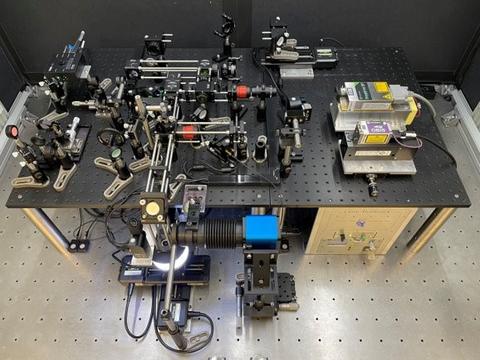Thermoreflectance Thermal Property Measurements for Heterogeneously Integrated Materials and Power Electronics
Summary
The thermal properties of materials and interfaces that govern the performance, reliability, and thermal management in microelectronics packages and wide bandgap power electronics are not fully or easily characterized, especially at device length scales wherein the properties can differ significantly from bulk or literature values. Transient Thermoreflectance (TR) is the emergent metrology that can characterize the thermal properties of films, multilayer structures, and their interfaces.
This project will validate and improve emergent TR methods to provide data, protocols, and reference standards, leveraging our existing expertise and collaborations with instrument vendors and the semiconductor industry.
Grand Challenge 4. Modeling and Simulating Semiconductor Materials, Designs, and Components
Description

Thermal conductivity, heat capacity, and interface conductance are fundamental properties that govern semiconductor microelectronic devices, from materials discovery, to design and modeling, thermal management and device performance, and ultimately device reliability and operational lifespan. These thermal properties are not adequately characterized, especially at device length scales and growth conditions. Fabrication methods, dopant implantation, and defects can further influence the thermal properties of materials.
Recently improved transient thermoreflectance (TR) optical measurement techniques are non-contact, non-destructive, spatially resolved, and can uniquely resolve the in-situ thermal properties of bulk, thin film, embedded, and multilayer material structures; measurements on these structures are especially difficult if not impossible using traditional thermal measurement methods. TR techniques can simultaneously probe over variable penetration depths, from ≈ 50 nm to ≈ 1 mm, and probe features with a spatial resolution smaller than ≈ 1 micron to ≈ 10 micron (adjustable via optics); these techniques can measure a wide range of thermal conductivity values from ≈ 0.1 W/mK to > 500 W/mK (with some techniques > 2000 W/mK). 2D spatial thermal property maps can also be generated using translation stages. These dimensions and property ranges are especially useful to study wide bandgap power electronics, packaging materials, and integrated chip components. With advances in TR metrologies just in the last decade, and recent progress in commercialization, transient TR is poised as the emergent industry standard measurement technique to characterize the thermal properties of advanced microelectronics and power electronics materials and devices.
The lack of reliable and fundamental thermal property data constrains the efficient integration of complex packaging and critically limits thermal modeling. By leveraging our expertise in TR measurements, existing interactions with commercial instrumentation vendors, other agency partners, and academic collaborations, this project will:
- Improve thermoreflectance measurement methods to measure thermal properties of semiconducting materials and devices,
- Refine measurement protocols,
- Enable us to generate on-demand thermal property data for NIST and other collaborators, and
- Support the development of thermal conductivity reference standards that can improve the performance, reliability, and thermal management in microelectronics packages and wide bandgap power electronics.
TR measurements exploit a fundamental relationship between optical reflectance and temperature. The Coefficient of Thermoreflectance is a physical property that relates a material’s change in temperature to the resulting change in optical reflectance. This property is commonly used, for example, in commercial TR temperature imaging instruments to map the surface temperature of materials and devices. Transient TR thermal uses modulated laser heating and thermal models to probe fundamental thermal properties, including thermal conductivity, heat capacity, and interface conductance.
Objectives:
- Develop thermal conductivity standards that span the materials and property value ranges relevant for semiconductor devices.
- Leverage our existing custom-built Frequency Domain TR (FDTR) instrument, expertise, and collaborations to improve and refine the transient TR thermal measurement methods, protocols, and instrumentation.
- Support companies that are currently or are planning to commercialize these emerging thermal measurement techniques, through purchasing and evaluating a customized commercial instrument, performing measurement comparisons, and identifying the practical strengths and limitations of TR metrologies for the semiconductor industry.
- Using our existing FDTR instrument and a customized commercial SSTR instrument, provide independent verification and validation measurements to improve thermal management in wide bandgap Field Effect Transistors (FETs).
- Using our expertise and the customized commercial SSTR instrument, provide access and/or on-demand thermal property measurements that directly support other CHIPS related projects and collaborators.
- Design and construct a new TDTR thermal metrology instrument to better measure thermal interface conductance. To leverage our instrumentation and transport metrology expertise, we envision the construction of a new Heterodyne Time Domain Thermoreflectance (TDTR) instrument to complement and extend the capabilities of our existing FDTR instrument.

